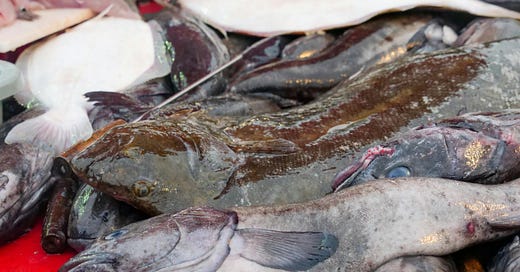You probably have some idea if you’re a slow eater or a fast one, but do you have any idea how long it would take you to, say, eat 100 grams of fish?
Well, apparently scientists have measured how fast people eat, and while there are varying estimates, it seems to be about 1-3 minutes per 100 grams of food.
Scientists have also recently measured how long fish feel pain for when they’re taken out of water. While it depends on the species and the circumstances, they find that it lasts between 2 and 25 minutes. The study even introduces the somewhat disturbing metric of pain per kilogram, finding that “when standardized by production output, this corresponds to an average of 24 minutes per kilogram”.
These two seemingly unrelated pieces of information allow us to calculate a rather dystopian metric ourselves. Looking at the estimated ranges for how fast people eat, let’s generously assume the average is towards the slower end of the range and that it therefore takes the average person 2.4 minutes to eat 100 grams of food.
That means that for every minute you spend enjoying a plate of fish, that fish experienced one minute of excruciating pain.
But what exactly does it mean for fish to feel pain? Here’s how the scientists describe it. Keep in mind these are scientists writing for Nature, coldly explaining facts rather than appealing to our emotions:
“As soon as individuals are out of water, intensive aversive reactions and movements are observed… vigorous movements of twisting and turning and escape attempts… a maximal emergency response that is consistent with both Disabling and Excruciating pain categories.”
“Exposure to higher levels of CO₂ also triggers a feeling of severe breathlessness, an increasingly distressing urge to breathe… panic due to the escalating hypercapnia.”
“Ischemia can also trigger the release of inflammatory mediators, increasing pain.”
In summary, for every minute you spend chewing on some fish, the fish experienced one minute of what you’ve just read.
I suspect the link between you eating fish and the fish feeling pain might still sound a little abstract, so here’s how you can try to visualize it: imagine there’s a fish torturer sitting in front of you at dinner. You’re not even eating fish, just some delicious and rare variety of chocolate. The second you start munching away at the chocolate, the fish torturer starts torturing that fish in front of you. The second you stop, he stops too.
Do you think you’d enjoy your desert if this was what you had to endure every time you wanted to eat that chocolate?
Of course, in this example the torturer sounds like an antagonist hell-bent on ruining your dinner; when, in reality, the more accurate analogy would be a torturer that you’ve hired specifically to provide this service, because for some reason the only way to buy this particular type of chocolate is if a fish gets tortured at the same time. Imagine there are plenty of other things on the menu that you would likely enjoy to a similar degree, but you specifically picked the chocolate paired with the fish torturer.
It’d be pretty weird to still pick the chocolate, right?
It’s easy to dissociate what’s on your plate with the toll on life that it took to bring that taste to you, but I think these examples neatly illustrate just how psychotic modern consumption patterns have become. The fish you eat will give you a few minutes of pleasure before you move on to the next thing and forget all about it, flushing its remains down the toilet. Yet for every minute of your pleasure, that fish endured a minute of agony; slowly suffocating to death. The fact that this is a 1:1 relationship would be poetic if it weren’t so grim.
Next time you’re looking at a menu and considering the fish, why not ask yourself: how long will it take to eat? And if you had to watch a fish be tortured in front of you for that same amount of time while you ate it, would you still consider ordering it?




